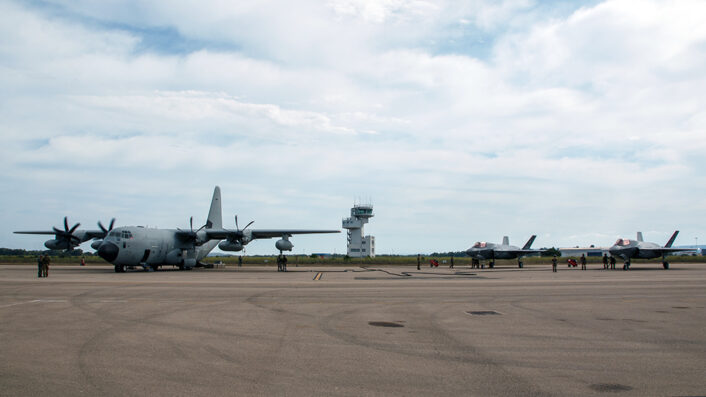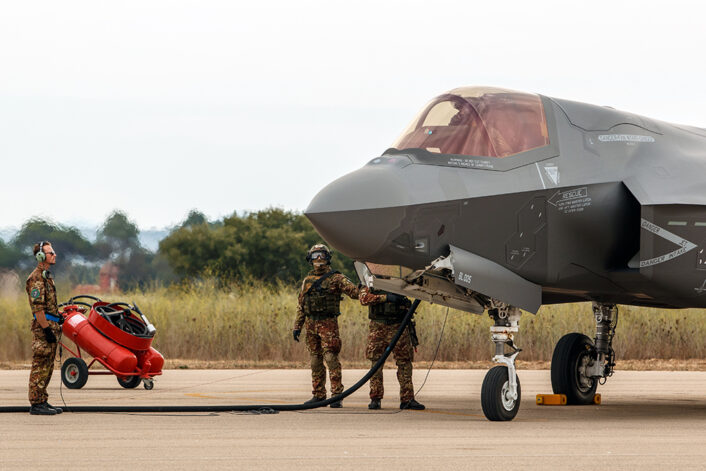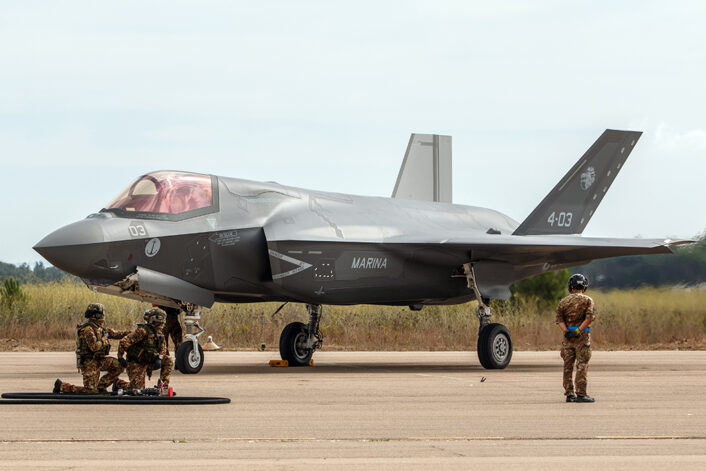Italian Air Force and Navy F-35B STOVL (Short Take Off Vertical Landing) aircraft carried out a joint expeditionary drill at Alghero Airport.
After conducting several expeditionary exercises on the tiny island of Pantelleria where the local airfield has been used as a forward operating base for F-35Bs of the Aeronautica Militare (Italian Air Force), Marina Militare (Italian Navy) (and also the Royal Air Force) the Italian Defense has moved Alghero, on the northwestern coast of Sardinia, to carry out the latest ALARP (Air Landed Aircraft Refuelling Point) drill.
In fact, on Aug. 31, 2022, an F-35B of the and one of the Marina Militare deployed to the Sardinian airport, where an austere runway (basically meaning a short runway located in a semi-permissive environment with limited ground support available) was simulated, carried out a hot-pit refueling with a KC-130J of the 46^ Brigata Aerea (Air Brigade) from Pisa, and took off again to take part in a mission inside PISQ (Poligono Interforze Salto di Quirra – Salto di Quirra Joint Range), a large EW range located over central-east Sardinia, that also involved two F-35As and two Eurofighters.
Aeroporto di #Alghero, Sardegna
Addestramento congiunto Alarp (Air Landed Aircraft Refuelling Point) di #AeronauticaMilitare e #MarinaMilitare con 2 #F35B appartenenti alle 2 #ForzeArmate🇮🇹
Un’ulteriore occasione per accrescere l’interoperabilità interforze#UnaForzaperilPaese pic.twitter.com/tVb3ejpStp
— Forze Armate StatoMaggioreDifesa (@SM_Difesa) August 31, 2022
There are many reasons why the Alghero event was worth of remark.

First of all, as already said, it was the first time the activities were conducted at Alghero, an airport normally used for commercial flights only.
Second, it shows that the “marriage” between the Italian Air Force and Navy is still pretty solid, after the tensions of the past: after the first landing of an Italian Air Force F-35B on the Italian Navy aircraft carrier Cavour in November 2021 the two services have already operated together in a previous joint austere runway exercise on Pantelleria earlier this year.
Third, it shows the Italian Air Force is betting big on expeditionary operations, as also confirmed by the short deployment of the two F-35Bs the service has already received (out of a total of 15), to Keflavik, Iceland, during the F-35A rotation in support of NATO’s Icelandic Air Policing, in June this year.

The Italian Air Force considers the F-35B and its STOVL capability a crucial component of a larger expeditionary system that makes the service capable to project power far from home, in a semi-permissive environment, on an austere/bare runways normally not usable by other conventional aircraft and with limited Force Protection provided by the host nation. “In Africa there are about 100 runways that have a length between 2,800 and 3,000 meters but there are 20 times as many runways between 1,000 and 1,500 meters in length,” Gen. Alberto Rosso, former Chief of Staff told in 2020, when addressing the media at Pantelleria during the F-35B’s Expeditionary Proof of Concept. “Being able to use short runways allows you to multiply your ability to deploy where needed, in a more convenient and faster way, especially closer to the area of operation. Having an aircraft that is capable of taking off from shorter runways allows incredible flexibility even in those scenarios that are currently only barely conceivable. In case of conflict, aircraft that are able to operate from shorter runways can also be dispersed to increase their survivability.”
While there won’t be a Lightning Force (i.e. a joint Squadron equipped with F-35Bs jointly flown and maintained from the two services – as done in the UK by the RAF and Royal Navy), the Italians aim at a “joint capability” with the Italian Air Force and Navy operating their own aircraft in their own units at their respective homebases (Amendola for the Air Force and Grottaglie for the Navy). However, when needed, the F-35Bs of both services will integrate and operate under a single chain of command from land-bases or from an aircraft carrier or landing helicopter dock (like the LHD Trieste that will be ready to accommodate the aircraft next year) by means of a TOA (Transfer Of Authority).

If the current plans are confirmed, the Aeronautica Militare and Marina Militare will operate 15 F-35Bs each: while the Air Force will use the Lightning II to field this new tactical expeditionary capability and also replace the AMX (soon to be retired), the Navy will use the F-35B to replace the AV-8B+ Harrier II (whose retirement is planned for 2024-2025 – at that time the naval service should be equipped with at least 8 F-35Bs).









